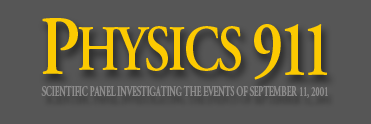Active Thermitic Material Discovered in Dust from the 9/11 World Trade Center Catastrophe
Active Thermitic Material Discovered in Dust from the 9/11 World Trade Center Catastrophe
Study by Niels H. Harrit, Jeffrey Farrer, Steven E. Jones, Kevin R. Ryan, Frank M. Legge, Daniel Farnsworth, Gregg Roberts, James R. Gourley, Bradley R. Larsen
Abstract: We have discovered distinctive red/gray chips in all the samples we have studied of the dust produced by the destruction of the World Trade Center. Examination of four of these samples, collected from separate sites, is reported in this paper. These red/gray chips show marked similarities in all four samples. One sample was collected by a Manhattan resident about ten minutes after the collapse of the second WTC Tower, two the next day, and a fourth about a week later. The properties of these chips were analyzed using optical microscopy, scanning electron microscopy (SEM), X-ray energy dispersive spectroscopy (XEDS), and differential scanning calorimetry (DSC). The red material contains grains approxi- mately 100 nm across which are largely iron oxide, while aluminum is contained in tiny plate-like structures. Separation of components using methyl ethyl ketone demonstrated that elemental aluminum is present. The iron oxide and aluminum are intimately mixed in the red material. When ignited in a DSC device the chips exhibit large but narrow exotherms oc- curring at approximately 430 ÌŠC, far below the normal ignition temperature for conventional thermite. Numerous iron-rich spheres are clearly observed in the residue following the ignition of these peculiar red/gray chips. The red portion of these chips is found to be an unreacted thermitic material and highly energetic.

Keywords: Scanning electron microscopy, X-ray energy dispersive spectroscopy, Differential scanning calorimetry, DSC analysis, World Trade Center, WTC dust, 9/11, Iron-rich microspheres, Thermite, Super-thermite, Energetic nanocomposites, Nano-thermite.
INTRODUCTION
The destruction of three skyscrapers (WTC 1, 2 and 7) on September 11, 2001 was an immensely tragic catastrophe that not only impacted thousands of people and families di- rectly, due to injury and loss of life, but also provided the motivation for numerous expensive and radical changes in domestic and foreign policy. For these and other reasons, knowing what really happened that fateful day is of grave importance.
A great deal of effort has been put forth by various government-sponsored and funded investigations, which led, in large part, to the reports released by FEMA [1] and NIST [2]. Other studies of the destruction have been less well publicized but are no less important to the outstanding obliga- tion that remains to the victims of that tragedy, to determine the whole truth of the events of that day [3-10]. A number of these studies have appropriately focused attention on the re- maining physical material, and on available photographs and video footage, as sources of evidence still in public hands, relating to the method of destruction of the three skyscrapers.
The collapses of the three tallest WTC buildings were remarkable for their completeness, their near free-fall speed [11] their striking radial symmetry [1, 12] and the surpris- ingly large volume of fine toxic dust [13] that was generated. In order to better understand these features of the destruc- tion, the authors initiated an examination of this dust. In June 2007, Dr. Steven Jones observed distinctive bi-layered chips, with both a red and a gray layer, in a sample of the WTC dust. Initially, it was suspected these might be dried paint chips, but after closer inspection and testing, it was shown that this was not the case. Further testing was then performed on the red/gray chips in an attempt to ascertain their composition and properties. The authors also obtained and exam- ined additional samples of WTC dust which had been col- lected by independent observers on, or very soon after, 9/11. All of the samples examined contained these very small, peculiar red/gray chips. Previous studies discussing observa- tions of the WTC dust include reports by the RJ Lee Com- pany [14], the U.S. Geological Survey (USGS) [15], McGee et al. [13] and Lioy et al. [16] Some of these studies con- firmed the finding of iron-rich microspheres, which are also peculiar [5, 8, 11, 13-15] but the red/gray chips analyzed in this study have apparently not been discussed in previously published reports. It is worth emphasizing that one sample was collected about ten minutes after the collapse of the sec- ond Tower, so it cannot possibly have been contaminated by clean-up operations [17]…
Please click on this link to see the complete study (PDF document)





 List of Members
Log in
List of Members
Log in